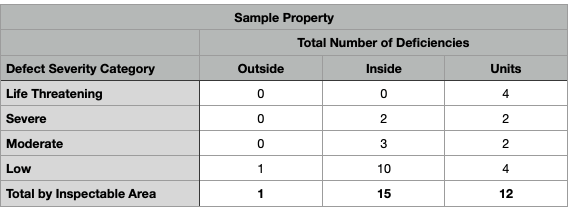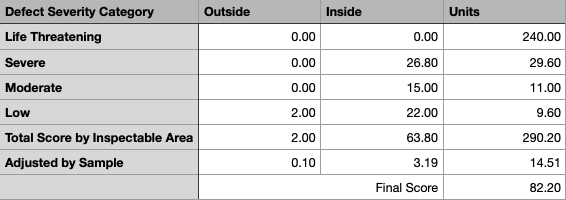HUD published the NSPIRE Scoring Notice requesting comments on the new scoring methodology. nnAs expected, the NSPIRE scoring methodology is considerably easier to understand and work with than under UPCS. HUD has developed the following table, which shall be applicable to all properties:

The math is essentially as follows: For each of the categories above, the number of deficiencies on an inspection will be multiplied by the number in this chart, and then that value will be divided by the unit sample. So, for instance, if an inspection contains 20 sampled units, and there are five life-threatening issues in the units, the score for that section would be 60 x 5, which is 300, and then divided by the unit sample of 20, resulting in 15. That number is deducted from 100, resulting in a score of 85.
This method transforms REAC scoring from trigonometry to middle school math, which will result in much more transparent scoring results.
Here’s an example:
This property has a total of 28 deficiencies and a sample of 20 Units. 

Below you will see the end result of the equation:


Other changes noted in this notice include the following:
- New Sampling: The NSPIRE unit sampling has changed from the methodology used in UPCS since 1999. The changes slightly increase the number of units inspected for most properties. For instance, a property with 45 units used to have a sample of 17 units under NSPIRE. The sample will be increased to 19 at this property. The full chart of the new sampling methodology can be viewed here.
- Building Inspection Methods: Under NPSIRE, if a building does not contain any sampled units, the building will simply be excluded from the inspection.
- New Affirmative Requirements: In at least the first 12 months after the effective date of the final NSPIRE Rule, a designation to be determined will also be included as part of the property’s inspection results to indicate new affirmative requirements that were not scored. Standards needing more calibration through field testing, such as a minimum temperature standard, may not be scored for more than a year. In at least the initial year of NSPIRE, HUD will also provide two scores; one that shows the possible score if all new affirmative requirements were scored and the official score for that inspection.
- Rounding: Calculated scores will be rounded to the nearest whole number with one exception. For properties that score between 59 and 60, the score will be rounded down to 59.
- Smoke Detectors and CO Alarm issues will continue to be non-scoring in keeping with the longstanding practice of not scoring smoke detector defects under the UPCS scoring methodology. HUD will not score smoke detector defects but will continue to use an asterisk (*) to denote identified smoke detector defects.


